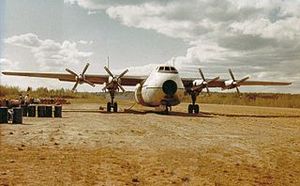Argosy AW650
| AW.650 & AW.660 Argosy | |
|---|---|
 |
|
| Armstrong-Whitworth AW.650 Argosy | |
| Role | Cargo Transport |
| Manufacturer | Armstrong Whitworth |
| First flight | 8 January 1959 |
| Retired | 1991 |
| Primary user | Royal Air Force |
| Number built | 74 |
The Armstrong Whitworth Argosy was a British post-war military transport/cargo aircraft and was the last aircraft produced by Armstrong Whitworth Aircraft. Although given different type numbers, the AW.650 civil and AW.660 military models were both called "Argosy" and for practical purposes are basically the same design.
The Argosy came from the Air Ministry "Operational Requirement 323" (OR323) which resulted in a specification issued in 1955 for a medium-range freight aircraft capable of lifting 25,000 lb (11,340 kg) and that had a range of 2,000 mi (3,200 km) with 10,000 lb (4,500 kg). This led AW to develop a twin-engine design for the military, the AW.66. The potential for civil sales led to a civil design AW.65, which differed by having full section doors at each end of the fuselage to allow quick loading and unloading. A lack of funds led to abandonment of the military requirement, but Armstrong Whitworth had already decided to go ahead with the civil variant as a private venture, it being redesigned with four Rolls-Royce Darts as the AW.650.
The AW.650 was a high-wing four-engined general-purpose transport aircraft, powered by four Rolls-Royce Dart turboprop engines driving Rotol four-blade propellers. The tailplane was on twin booms from the inner engine nacelles, leaving the cargo doors at the rear of the fuselage clear for straight-in loading, while sideways-opening doors were fitted at both ends of the fuselage, with the flight deck high up in the nose. This gave an unobstructed cargo space measuring 10 by 47 feet (3.0 m × 14.3 m) with a sill height corresponding to that of a normal flatbed truck. This unusual "pod and boom" structure, similar to the earlier C-82 Packet and C-119 Flying Boxcar transports, would earn it the nickname "The Whistling Wheelbarrow". It had a maximum weight of 88,000 lb (39,915 kg) and a payload of 28,000 lb (12,700 kg). Cruising at 276 mph (444 km/h), it had a range of 1,780 mi (2,865 km) and could seat 89 passengers. The first Argosy made its maiden flight on 8 January 1959, receiving Federal Aviation Administration type certification on 2 December 1960. 10 of the initial civil version, the Series 100, were built.
...
Wikipedia
